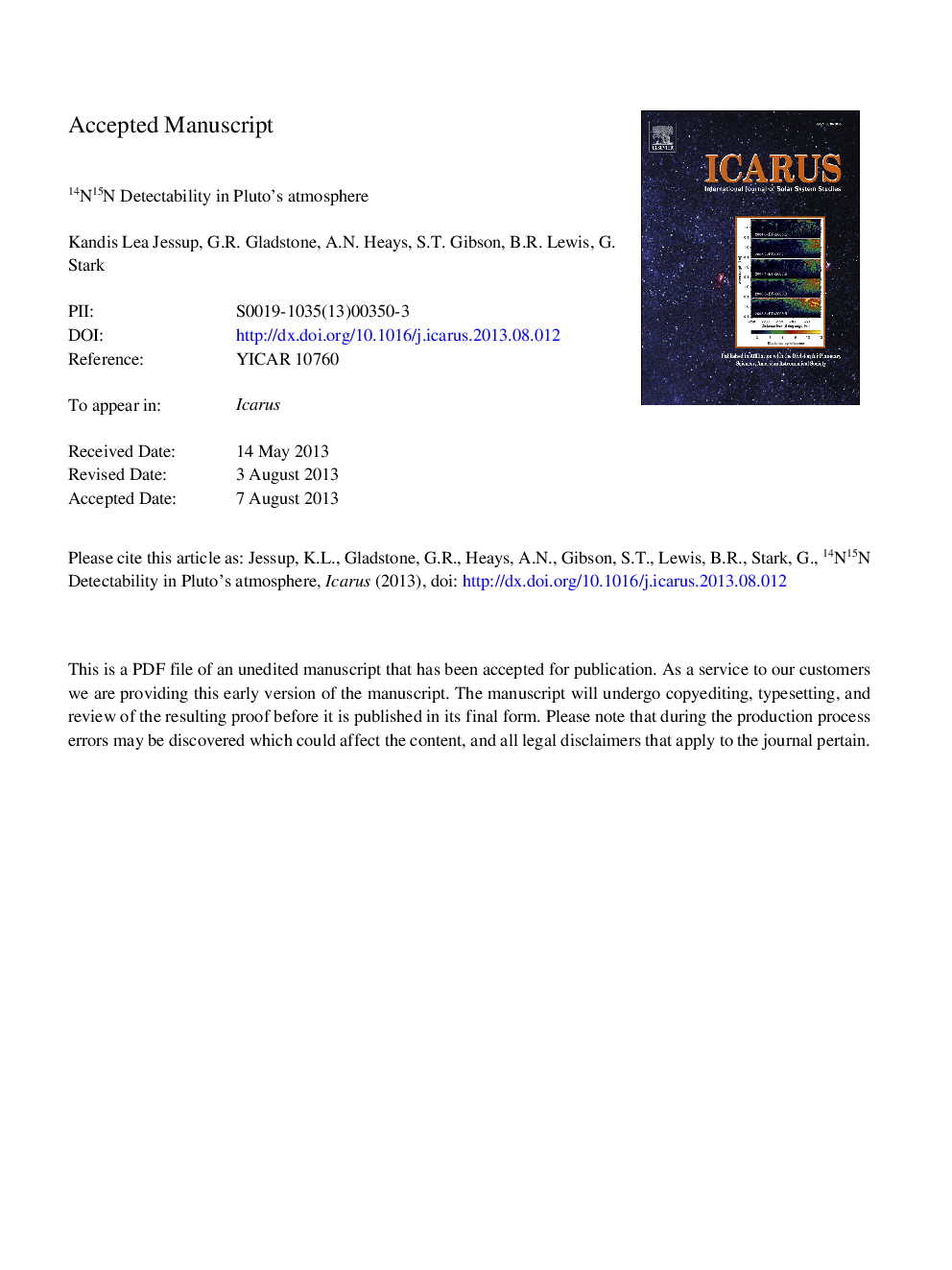| کد مقاله | کد نشریه | سال انتشار | مقاله انگلیسی | نسخه تمام متن |
|---|---|---|---|---|
| 10701396 | 1021129 | 2013 | 40 صفحه PDF | دانلود رایگان |
عنوان انگلیسی مقاله ISI
14N15N detectability in Pluto's atmosphere
دانلود مقاله + سفارش ترجمه
دانلود مقاله ISI انگلیسی
رایگان برای ایرانیان
کلمات کلیدی
موضوعات مرتبط
مهندسی و علوم پایه
علوم زمین و سیارات
علوم فضا و نجوم
پیش نمایش صفحه اول مقاله

چکیده انگلیسی
Based on the vapor pressure behavior of Pluto's surface ices, Pluto's atmosphere is expected to be predominantly composed of N2 gas. Measurement of the N2 isotopologue 15N/14N ratio within Pluto's atmosphere would provide important clues to the evolution of Pluto's atmosphere from the time of formation to its present state. The most straightforward way of determining the N2 isotopologue 15N/14N ratio in Pluto's atmosphere is via spectroscopic observation of the 14N15N gas species. Recent calculations of the 80-100 nm absorption behavior of the 14N2 and 14N15N isotopologues by Heays et al. (Heays, A.N. et al. [2011]. J. Chem. Phys. 135, 244301), Lewis et al. (Lewis, B.R., Heays, A.N., Gibson, S.T., Lefebvre-Brion, H., Lefebvre, R. [2008]. J. Chem. Phys. 129, 164306); Lewis et al. (Lewis, B.R., Gibson, S.T., Zhang, W., Lefebvre-Brion, H., Robbe, J.-M. [2005]. J. Chem. Phys. 122, 144302), and Haverd et al. (Haverd, V.E., Lewis, B.R., Gibson, S.T., Stark, G. [2005]. J. Chem. Phys. 123, 214304) show that the peak magnitudes of the 14N2 and 14N15N absorption bandhead cross-sections are similar, but the locations of the bandhead peaks are offset in wavelength by â¼0.05-0.1 nm. These offsets make the segregation of the 14N2 and 14N15N absorption signatures possible. We use the most recent N2 isotopologue absorption cross-section calculations and the atmospheric density profiles resulting from photochemical models developed by Krasnopolsky and Cruickshank (Krasnopolsky, V.A., Cruickshank, D.P. [1999]. J. Geophys. Res. 104, 21979-21996) to predict the level of solar light that will be transmitted through Pluto's atmosphere as a function of altitude during a Pluto solar occultation. We characterize the detectability of the isotopic absorption signature per altitude assuming 14N15N concentrations ranging from 0.1% to 2% of the 14N2 density and instrumental spectral resolutions ranging from 0.01 to 0.3 nm. Our simulations indicate that optical depth of unity is attained in the key 14N15N absorption bands located between 85 and 90 nm at altitudes â¼1100-1600 km above Pluto's surface. Additionally, an 14N15N isotope absorption depth â¼4-15% is predicted for observations obtained at these altitudes at a spectral resolution of â¼0.2-0.3 nm, if the N2 isotopologue 15N/14N percent ratio is comparable to the 0.37-0.6% ratio observed at Earth, Titan and Mars. If we presume that the predicted absorption depth must be at least 25% greater than the expected observational uncertainty, then it follows that a statistically significant detection of these signatures and constraint of the N2 isotopologue 14N/15N ratio within Pluto's atmosphere will be possible if the attainable observational signal-to noise (S/N) ratio is ⩾9. The New Horizons (NH) Mission will be able to obtain high S/N, 0.27-0.35 nm full-width half-max 80-100 nm spectral observations of Pluto using the Alice spectrograph. Based on the NH/Alice specifications we have simulated 0.3 nm spectral resolution solar occultation spectra for the 1100-1600 km altitude range, assuming 30 s integration times. These simulations indicate that NH/Alice will obtain spectral observations within this altitude range with a S/N ratio â¼25-50, and should be able to reliably detect the 14N15N gas absorption signature between 85 and 90 nm if the 14N15N concentration is â¼0.3% or greater. This, additionally, implies that the non-detection of the 14N15N species in the 1100-1600 km range by NH/Alice may be used to reliably establish an upper limit to the N2 isotopologue 15N/14N ratio within Pluto's atmosphere. Similar results may be derived from 0.2 to 0.3 nm spectral resolution observations of any other N2-rich Solar System or exoplanet atmosphere, provided the observations are attained with similar S/N levels.
ناشر
Database: Elsevier - ScienceDirect (ساینس دایرکت)
Journal: Icarus - Volume 226, Issue 2, NovemberâDecember 2013, Pages 1514-1526
Journal: Icarus - Volume 226, Issue 2, NovemberâDecember 2013, Pages 1514-1526
نویسندگان
Kandis Lea Jessup, G.R. Gladstone, A.N. Heays, S.T. Gibson, B.R. Lewis, G. Stark,